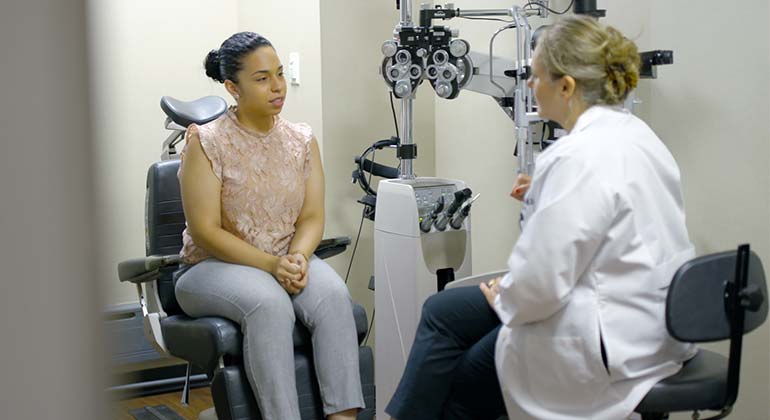Andalusia Ophthalmologist: Specialist Eye Doctors in Your Location
Andalusia Ophthalmologist: Specialist Eye Doctors in Your Location
Blog Article
The Pros and Cons of Various Refractive Surgeries for Improved Eyecare

LASIK Surgical Treatment
LASIK surgical treatment is a commonly done refractive procedure that aims to deal with vision issues such as farsightedness, astigmatism, and nearsightedness. Throughout the treatment, a slim flap is produced on the cornea, and a laser is made use of to reshape the underlying tissue, dealing with the refractive mistake.
One of the primary benefits of LASIK surgical procedure is the rapid enhancement in vision experienced by lots of patients. It is crucial for individuals thinking about LASIK surgery to undergo a detailed analysis by an eye care specialist to figure out if they are suitable prospects for the treatment.
PRK Procedure
The PRK procedure, additionally known as Photorefractive Keratectomy, is a kind of refractive surgical procedure that aims to correct vision concerns comparable to LASIK surgical procedure. Unlike LASIK, which includes developing a flap in the cornea, PRK works on the surface area layer of the cornea.
Among the advantages of PRK over LASIK is that it gets rid of the threat of flap-related difficulties since no flap is produced during the surgical procedure. This can be beneficial for people with slim corneas or those associated with contact sports where eye trauma is an opportunity. Nevertheless, the healing time for PRK is usually longer contrasted to LASIK, as the outer layer of the cornea needs time to regrow after the procedure. Despite the longer recuperation period, PRK can be a suitable choice for people seeking vision modification surgical procedure.
SMILE Surgery
A sophisticated refractive surgical procedure method gaining appeal in the area of ophthalmology is SMILE Surgery. Small Cut Lenticule Removal (SMILE) is a minimally intrusive treatment that corrects vision by reshaping the cornea making use of a femtosecond laser. Unlike conventional LASIK surgical procedure, SMILE Surgical procedure involves developing a little cut in the cornea to draw out a lenticule, which results in less disruption to the corneal structure and possibly faster recuperation times.
Among the primary advantages of SMILE Surgical procedure is its ability to deal with nearsightedness (nearsightedness) and astigmatism with high precision, resulting in excellent visual end results for people. The minimally intrusive nature of the procedure also lowers the threat of issues such as completely dry eye syndrome, making More Bonuses it a desirable choice for individuals looking for refractive surgery.

LASEK Technique
Having discovered the benefits and factors to consider of SMILE Surgical treatment, another noteworthy refractive surgical procedure strategy worth examining is the LASEK Method. LASEK, which stands for Laser-Assisted Subepithelial Keratectomy, is a form of laser eye surgical procedure that aims to remedy refractive mistakes such as myopia (nearsightedness), hyperopia (farsightedness), and astigmatism.
Unlike LASIK, LASEK does not include producing a corneal flap. Rather, throughout a LASEK procedure, the specialist makes use of a diluted alcohol remedy to loosen the slim external layer of the cornea, called the epithelium. This layer is after that delicately moved aside to permit the laser to improve the underlying corneal tissue. As soon as the cornea has actually been reshaped to the desired level, the epithelial layer is repositioned.
One of the primary benefits of LASEK is that it can be suitable for individuals with thin corneas who may not be excellent candidates for LASIK. Additionally, LASEK typically causes very little post-operative discomfort and a quicker healing time contrasted a fantastic read to PRK. The aesthetic recuperation process with LASEK might be somewhat longer than with LASIK.
Implantable Get In Touch With Lenses
Implantable Get in touch with Lenses provide a long-term vision improvement service for individuals seeking an option to conventional call lenses or glasses. These lenses, likewise called phakic intraocular lenses, are operatively put into the eye to deal with refractive errors such as nearsightedness (nearsightedness), hyperopia (farsightedness), and astigmatism. neurologist Andalusia. Unlike conventional get in touch with lenses that rest on the surface area of the eye, implantable get in touch with lenses work within the eye itself, supplying clear vision without the requirement for daily maintenance or removal
One of the crucial advantages of implantable call lenses is their durability. When placed, they can remain in the eye forever, offering secure and constant vision modification. Furthermore, these lenses can be a superb alternative for people who are not great candidates for laser eye surgery or that favor a relatively easy to fix vision adjustment procedure.
Nonetheless, implantable contact lenses do lug some risks, consisting of the possibility for cataracts or boosted eye stress. It is critical for individuals considering Website this option to talk to an eye treatment specialist to establish if implantable call lenses are the ideal option for their specific needs and eye health.
Verdict
In final thought, each kind of refractive surgical procedure has its own benefits and negative aspects. LASIK surgical treatment is preferred for its fast recuperation time, while PRK treatment may be suitable for clients with thin corneas.

In General, SMILE Surgical procedure presents a promising alternative for people looking to boost their vision with refractive surgery.
Report this page